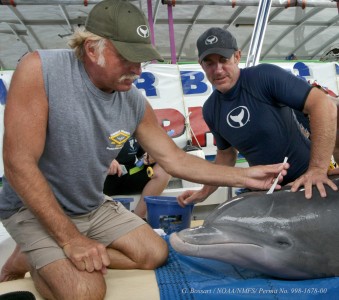NSU Newsroom
SharkBytes
Horizons
This version of NSU News has been archived as of February 28, 2019. To search through archived articles, visit nova.edu/search. To access the new version of NSU News, visit news.nova.edu.
This version of SharkBytes has been archived as of February 28, 2019. To search through archived articles, visit nova.edu/search. To access the new version of SharkBytes, visit sharkbytes.nova.edu.
Nova Southeastern University Researchers Uncover Genetic Surprises in Florida’s Bottlenose Dolphins
FORT LAUDERDALE-DAVIE, Fla. – The old saying goes: “Don’t judge a book by its cover.” Well, the same could be said about bottlenose dolphins.
Bottlenose dolphins are the most common and well-known of their kind – famous in TV and movies. And while one bottlenose dolphin might look similar to another, when you take a closer look at them (really close, as in genetically,) there are differences. In fact, a recently published study in the Journal of Heredity (Vol. 104, pp 765-778) focused on groups of these animals that live in specific areas along the eastern seaboard of the United States, comparing them to other bottlenose dolphins that live offshore, in the northwest Atlantic Ocean, Gulf of Mexico and the Caribbean.
Specifically, the study looked at bottlenose dolphins that lived within the Indian River Lagoon (IRL) on Florida’s east coast. The IRL runs from the Jupiter Inlet at the south to the Ponce de Leon Inlet to the north. Those animals were studied from a habitat and behavioral perspective as well as genetically, with some surprising results.
“It certainly took a while for the research to be conducted, data compiled and the findings to be confirmed and published, but it was worth the wait,” said Jose Lopez, Ph.D., a professor at Nova Southeastern University’s Oceanographic Center who was with FAU when the study began. “This was truly a collaborative effort, with experts from across the globe participating – and what we found was really fascinating.”
The nearly decade-long study was a team effort that involved Nova Southeastern University, Florida Atlantic University’s Harbor Branch Oceanographic Institute (HBOI,) the National Oceanic and Atmospheric Administration (NOAA); Cornell University; National Institutes of Health; and the University of Durham in England.
“Overall, this highly collaborative study now establishes a genetic baseline for the IRL dolphin population,” explained Steve McCulloch, HBOI MMRC program manager. “It can be used as a foundation for future genetic studies and to assist environmental and stock management of the iconic species.”
This first-of-its-kind study revealed that within the IRL, there are two different, distinct populations of bottlenose dolphins living in the waters. After the data were analyzed, researchers were able to determine that these two, genetically different groups were divided along a north-south geographic area of the IRL. Along with identifying genetic differences in the animals within the IRL, when compared to bottlenose dolphins that live in other areas, including the open oceanic waters, additional differences were found.
“This study shows evidence that while it may appear that the bottlenose dolphins within the IRL look the same, from a genetic – and geographic standpoint – there are differences,” Lopez said. “It’s akin to the Hatfields and McCoys or Capulet/Montague stories, that is, different families that are unmistakably of the same species, but for whatever reason living apart. As we work to protect the IRL, this study provides baseline data moving forward as we continue to monitor and study the wildlife that call the area home.”
While there were many findings identified, this study also provides important management implications since it’s clear the role of the habitat, and subsequent modifications, can directly shape bottlenose dolphin structure.
###
About Nova Southeastern University: Situated on 314 beautiful acres in Ft. Lauderdale, Florida, Nova Southeastern University (NSU) is a dynamic fully accredited research institution dedicated to providing high-quality educational programs at all levels. NSU is a not-for-profit independent institution with an enrollment of 27,000 students. NSU awards associate’s, bachelor’s, master’s, specialist, doctoral and first-professional degrees in a wide range of fields. NSU is classified as a research university with “high research activity” by the Carnegie Foundation for the Advancement of Teaching, and it is one of only 37 universities nationwide to also be awarded Carnegie’s Community Engagement Classification. For more information, please visit www.nova.edu
About NSU’s Oceanographic Center: The Oceanographic Center provides high-quality graduate education programs (i.e. masters, doctoral, certificate) in a broad range of marine science disciplines. Center researchers carry out innovative, basic and applied marine and research programs in coral reel biology, ecology, and geology; fish biology, ecology, and conservation; shark and billfish ecology; fisheries science; deep sea organismal biology and ecology; invertebrate and vertebrate genomics, genetics, molecular ecology, and evolution; microbiology; biodiversity; observation and modeling of large scale ocean circulation, coastal dynamics, and ocean atmosphere coupling; benthic habitat mapping; biodiversity; histology; and calcification. For more information, please visit http://www.nova.edu/ocean
About FAU’s Harbor Branch Oceanographic Institute: Founded in 1971, Florida Atlantic University’s Harbor Branch Oceanographic Institute is a research community of marine scientists, engineers, educators and other professionals focused on Ocean Science for a Better World. The institute drives innovation in ocean engineering, at-sea operations, drug discovery and biotechnology from the oceans, coastal ecology and conservation, marine mammal research and conservation, aquaculture, ocean observing systems and marine education. For more information, please visit www.fau.edu/hboi
Media Contacts:
Joe Donzelli | Office of Public Affairs
954-262-2159 (office) | jdonzelli@nova.edu
Carin Smith | FAU Harbor Branch Oceanographic Institute
772-242-2230 | carinsmith@fau.edu
